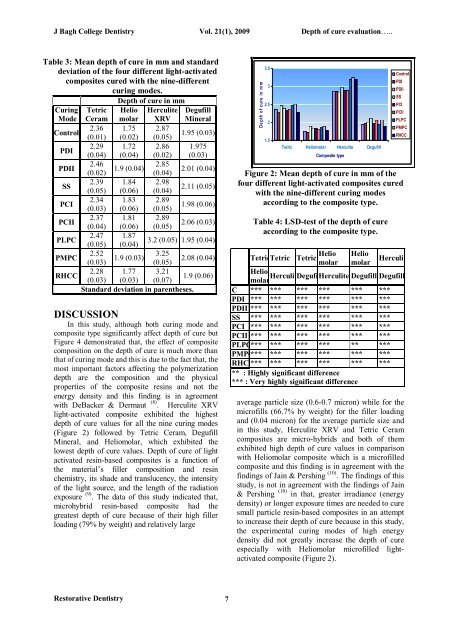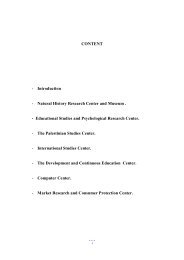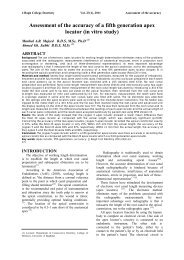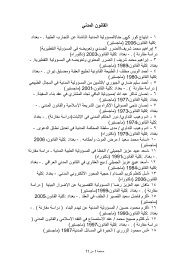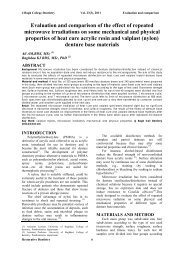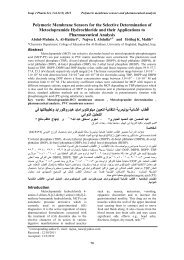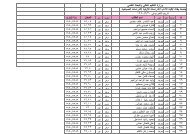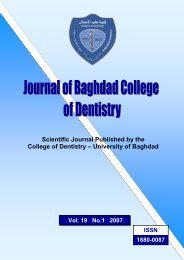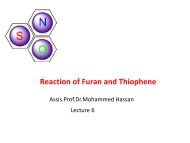Vol 21 No. 1
Vol 21 No. 1
Vol 21 No. 1
Create successful ePaper yourself
Turn your PDF publications into a flip-book with our unique Google optimized e-Paper software.
J Bagh College Dentistry <strong>Vol</strong>. <strong>21</strong>(1), 2009 Depth of cure evaluation…..<br />
Table 3: Mean depth of cure in mm and standard<br />
deviation of the four different light-activated<br />
composites cured with the nine-different<br />
curing modes.<br />
Depth of cure in mm<br />
Curing<br />
Mode<br />
Tetric<br />
Ceram<br />
Helio<br />
molar<br />
Herculite<br />
XRV<br />
Degufill<br />
Mineral<br />
Control<br />
2.36 1.75 2.87<br />
(0.01) (0.02) (0.05)<br />
1.95 (0.03)<br />
PDI<br />
2.29 1.72 2.86 1.975<br />
(0.04) (0.04) (0.02) (0.03)<br />
PDII<br />
2.46<br />
2.85<br />
1.9 (0.04)<br />
(0.02)<br />
(0.04)<br />
2.01 (0.04)<br />
SS<br />
2.39 1.84 2.98<br />
(0.05) (0.06) (0.04)<br />
2.11 (0.05)<br />
PCI<br />
2.34 1.83 2.89<br />
(0.03) (0.06) (0.05)<br />
1.98 (0.06)<br />
PCII<br />
2.37 1.81 2.89<br />
(0.04) (0.06) (0.05)<br />
2.06 (0.03)<br />
PLPC<br />
2.47 1.87<br />
(0.05) (0.04)<br />
3.2 (0.05) 1.95 (0.04)<br />
PMPC<br />
2.52<br />
3.25<br />
1.9 (0.03)<br />
(0.03)<br />
(0.05)<br />
2.08 (0.04)<br />
RHCC<br />
2.28 1.77 3.<strong>21</strong><br />
(0.03) (0.03) (0.07)<br />
1.9 (0.06)<br />
Standard deviation in parentheses.<br />
DISCUSSION<br />
In this study, although both curing mode and<br />
composite type significantly affect depth of cure but<br />
Figure 4 demonstrated that, the effect of composite<br />
composition on the depth of cure is much more than<br />
that of curing mode and this is due to the fact that, the<br />
most important factors affecting the polymerization<br />
depth are the composition and the physical<br />
properties of the composite resins and not the<br />
energy density and this finding is in agreement<br />
with DeBacker & Dermaut (8) . Herculite XRV<br />
light-activated composite exhibited the highest<br />
depth of cure values for all the nine curing modes<br />
(Figure 2) followed by Tetric Ceram, Degufill<br />
Mineral, and Heliomolar, which exhibited the<br />
lowest depth of cure values. Depth of cure of light<br />
activated resin-based composites is a function of<br />
the material’s filler composition and resin<br />
chemistry, its shade and translucency, the intensity<br />
of the light source, and the length of the radiation<br />
exposure (9) . The data of this study indicated that,<br />
microhybrid resin-based composite had the<br />
greatest depth of cure because of their high filler<br />
loading (79% by weight) and relatively large<br />
Depth of cure in mm<br />
3.5<br />
3<br />
2.5<br />
2<br />
1.5<br />
Tetric Heliomolar Herculite Degufill<br />
Composite type<br />
Control<br />
PDI<br />
PDII<br />
SS<br />
PCI<br />
PCII<br />
PLPC<br />
PMPC<br />
RHCC<br />
Figure 2: Mean depth of cure in mm of the<br />
four different light-activated composites cured<br />
with the nine-different curing modes<br />
according to the composite type.<br />
Table 4: LSD-test of the depth of cure<br />
according to the composite type.<br />
TetricTetric Tetric Helio Helio<br />
molar molar<br />
Herculite<br />
Helio<br />
HerculiteDegufillHerculite Degufill Degufill<br />
molar<br />
C *** *** *** *** *** ***<br />
PDI *** *** *** *** *** ***<br />
PDII *** *** *** *** *** ***<br />
SS *** *** *** *** *** ***<br />
PCI *** *** *** *** *** ***<br />
PCII *** *** *** *** *** ***<br />
PLPC*** *** *** *** ** ***<br />
PMPC*** *** *** *** *** ***<br />
RHCC*** *** *** *** *** ***<br />
** : Highly significant difference<br />
*** : Very highly significant difference<br />
average particle size (0.6-0.7 micron) while for the<br />
microfills (66.7% by weight) for the filler loading<br />
and (0.04 micron) for the average particle size and<br />
in this study, Herculite XRV and Tetric Ceram<br />
composites are micro-hybrids and both of them<br />
exhibited high depth of cure values in comparison<br />
with Heliomolar composite which is a microfilled<br />
composite and this finding is in agreement with the<br />
findings of Jain & Pershing (10) . The findings of this<br />
study, is not in agreement with the findings of Jain<br />
& Pershing (10) in that, greater irradiance (energy<br />
density) or longer exposure times are needed to cure<br />
small particle resin-based composites in an attempt<br />
to increase their depth of cure because in this study,<br />
the experimental curing modes of high energy<br />
density did not greatly increase the depth of cure<br />
especially with Heliomolar microfilled lightactivated<br />
composite (Figure 2).<br />
Restorative Dentistry 7


